Click here to print
Jack Shaheen’s Preservation of a Troubling Film Legacy
posted May 2, 2018
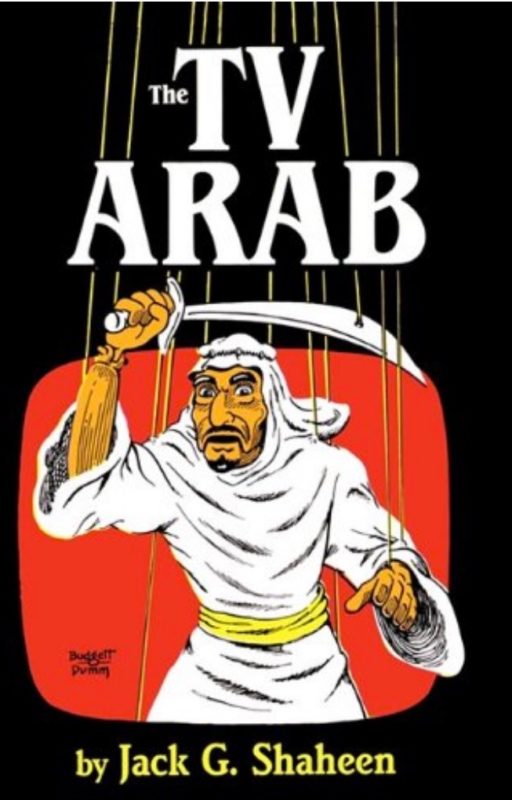
The cover of Jack G. Shaheen’s 1984 book, “The TV Arab.”
By Peter Monaghan
Hollywood and other branches of the American entertainment industry have frequently disparaged or otherwise abused Arabs and Muslims. Adverse depictions have long been so common as to be almost automatic.
How else could the facile colonialist underpinnings of, for example, the Indiana Jones series go so little remarked – not just the films’ indulgent flattery of Western historical deceptions regarding archaeological high-mindedness and heroism, but even more egregiously their simple substitution of Arabs, Indians, and other “others” for Native Americans as Hollywood’s go-to cannon fodder?
Hollywood representations of Arabs, Muslims, and Arab- and Muslim-Americans have almost always fallen into categories and types: the mustachioed villain, the violent schemer, the sexual predator, the Arabian Nights romantic… Then there are clichéd go-to tropes such as Arabs as cardboard-cutout Sheiks or Arab Maidens as oppressed, submissive, and dependent — unless they, too, are terrorists.
Those and other stereotypes are the study of a project at New York University based on an unusual collection: the archive donated in 2011 by Jack G. Shaheen.
Shaheen, who died in 2017, was a scholar and author who spent many years identifying and contesting stereotypes of Arabs and Muslims in American film and other media.
The collection he gave to New York University — to its Tamiment Library, Hagop Kervorkian Center for Near Eastern Studies, and Asian/Pacific/American Institute — included thousands of commercially produced feature films, many of which he recorded from television broadcasts onto videotapes.
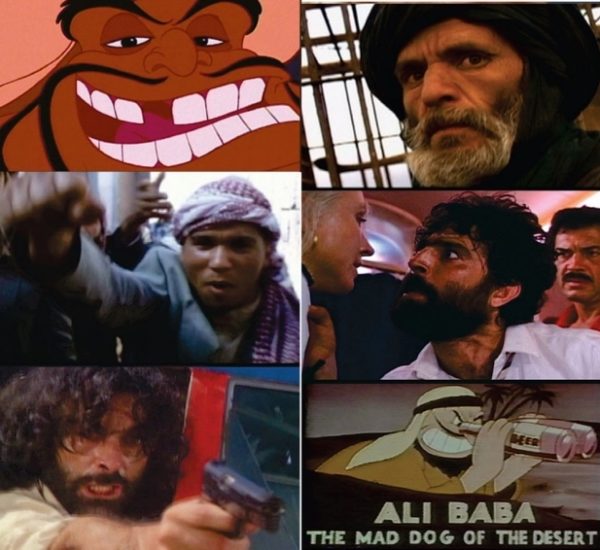
In film and television, demeaning caricatures of Arabs and Muslims abound. Image: Jack G. Shaheen Archive.
The 78.6 linear feet of record cartons, manuscript boxes, and the like that he donated contained material dating from 1943 to 2012. Among the material are almost 3,000 moving-image records including motion pictures, cartoons, newsreels, and televisions programs. With those came books, magazines, comic books, editorial cartoons, advertisements, toys, and games featuring demeaning or reductive depictions of Arabs and Muslims in the United States and around the world.
Also among the material are numerous of Shaheen’s scholarly and popular articles and other materials in media analysis, documents relating to his media-accountability activism through the American-Arab Anti-Discrimination Committee, and material relating to his consultation work for legal cases and the entertainment industry. The collection even includes Shaheen’s notes for his many lectures, articles, books, television appearances, and other activities relating to prejudicial images of Arabs and Muslims.
As for Shaheen’s moving-image collection, it consisted of films and copies of films — VHS tapes and DVDs — dating from the silent-film era of the early 1900s to the present. It includes documentary films, comedies, dramas, and children’s cartoons. Related material that Shaheen donated includes movie stills and posters, print advertisements, and teleplays relating to common depictions of Arabs and Muslims.
Jack Shaheen (1935–2017)
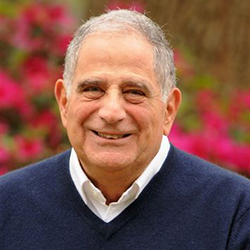
Jack G. Shaheen. Image: NYU.
Raised by Lebanese parents in a Pennsylvania steel town, Shaheen attended college in Pittsburgh, served in the US military, and then worked for the US government for three years in Germany. Returning to the US, he earned master’s and doctoral degrees in mass communication.
After he had begun university teaching, his children alerted him in the mid-1970s to what he called “some really ugly Arabs in a children’s cartoon.” At about that time, he traveled to the Middle East with his family on a Fulbright Fellowship, teaching extensively. On returning to the US, he said in a 2014 interview, “I decided to look at how Arabs were being portrayed on American television, and nothing had been written.” So he set about correcting that, taking his lead from studies of the bigoted portrayals of other ethnic, racial, and identity groups in American film and culture.
He said he decided not only to document depictions of Arab Americans, “but to go to the people responsible for the images.” For his first book, The TV Arab, published in 1984, he said, “I spoke to about 30 different television executives, writers, producers, directors, and I had to meet with them, which was very, very difficult because of the prejudices at the time.”
He argued that demeaning representations of Arabs and Muslims in popular culture have stemmed from longstanding “prejudices against the evil enemy, other people with dark skin, you know, the far East, whether they were Asians, Arabs, [or] blacks.”
The American civil-rights movement checked some of that venom, but Arab-Americans, and Arabs generally, remained common targets, he said: “The only group that remained in the forefront that continued to be vilified, and there was even an escalation, were Arabs and Islam.”
 Why? “It was easy,” he said, “and there was no pressure group, at all, and no one complained. Arab governments didn’t realize the impact and still don’t realize the impact of these images.”
Why? “It was easy,” he said, “and there was no pressure group, at all, and no one complained. Arab governments didn’t realize the impact and still don’t realize the impact of these images.”
American Arabs weren’t organized, in large part because, over all, they had relatively readily assimilated into American society. In any case, he added, most American Arabs are Christians and unfortunately for decades they had tolerated stereotypes that demeaned Arabs and Muslims in the Middle East, rather than those in the US.
It didn’t help that Arab Americans had virtually no presence or representation in Hollywood — no Arab-American writers, no directors: “We were not creating our own images.” Nor was there encouragement to do so: “There was a myth that if you created a good Arab you were pro-Arab and anti-Israel, as ridiculous as that sounds.”
In 2001, the terrorist attack of 9/11 made matters worse, he said: “It focused on American Arabs and American Muslims as a fifth unit, as a cell of terrorists.” It also divided Arab Americans by identifying them with Al-Qaeda. And then along came Rupert Murdoch’s Fox News, seeping with anti-Arab and anti-Muslim sentiment that oozed into Fox’s entertainment programming, as in the highly successful series, 24, which other networks emulated with shows like Sleeper Cell.
Of course, Shaheen allowed, few Americans are likely to watch films and television shows that are not pro-American in a conventionalized sense, with conventional American heroes; but, given opportunities, young Arab American filmmakers, and other Arab ones, might “alter the stereotypes,” he suggested.
Negative stereotypes do, of course, have real consequences, he noted. They deprive their targets of humanity, intimidate and shame many into silence, and shape public opinion.
 “And of course,” he added, “public opinion has an impact on policy and so all of the political leaders like President Obama think Homeland is a great TV series. Well, if I met with the President I can explain to him that it’s a very slick anti-Islam show/series.” It hinged on flattering viewers that they were above prejudice, he argued. And all the while, he said, venomous advocacy groups continued to thrive in the US, even producing documentary films that skillfully vilify Arabs and Muslims.
“And of course,” he added, “public opinion has an impact on policy and so all of the political leaders like President Obama think Homeland is a great TV series. Well, if I met with the President I can explain to him that it’s a very slick anti-Islam show/series.” It hinged on flattering viewers that they were above prejudice, he argued. And all the while, he said, venomous advocacy groups continued to thrive in the US, even producing documentary films that skillfully vilify Arabs and Muslims.
Intriguing archival challenges
Preserving the volume and variety of material in the Jack G. Shaheen Papers: Arabs in U.S. Film and Television, 1940-2002, and making it available for study, presents archivists with “intriguing” challenges, says Greta Scharnweber, until recently associate director of NYU’s Hagop Kevorkian Center for Near Eastern Studies. For example, Shaheen recorded films from television broadcasts onto VHS cassettes, and in some cases Umatic videocassettes. Digitizing all the recordings would be very expensive, so NYU archivists have prioritized.
For the initial stage of the digitization project, Scharnweber and colleagues at the Asian/Pacific/American Institute opted to transfer only 100 extended-play tapes of six hours, each, generally from the earliest of Shaheen’s recordings, in the 1970s. In the case of TV shows, Scharnweber says, the priority was to preserve examples that “wouldn’t be available anywhere, any more, such as bad TV shows that never made it to box sets, as they might today.” In the case of such television broadcasts, archivists have retained commercials and framing material that provide context.
Digitization was chosen as the preferred method of preservation, in part because many tapes had become fragile and would not stand up to much more playing. Brendan Allen, an archivist at Democracy Now, advised NYU archivists on the best methods for digitization.
Limiting the number of VHS tapes digitized was partly a matter of cost containment and space limitations, Scharnweber says: “When you watch a VHS cassette, the quality looks worse than on a DVD, but when you digitize the content from VHS, it’s a much larger file than it is for a DVD. So digitizing from tape takes up a lot more digital space than modern digital media.”
For copyright reasons, the collection’s materials generally are not openly available online, but can be viewed at NYU by appointment. Different kinds of recordings have been deposited in different parts of the NYU library system: newsreel footage; feature films released commercially on VHS or DVD; the television broadcasts…
A tireless advocate
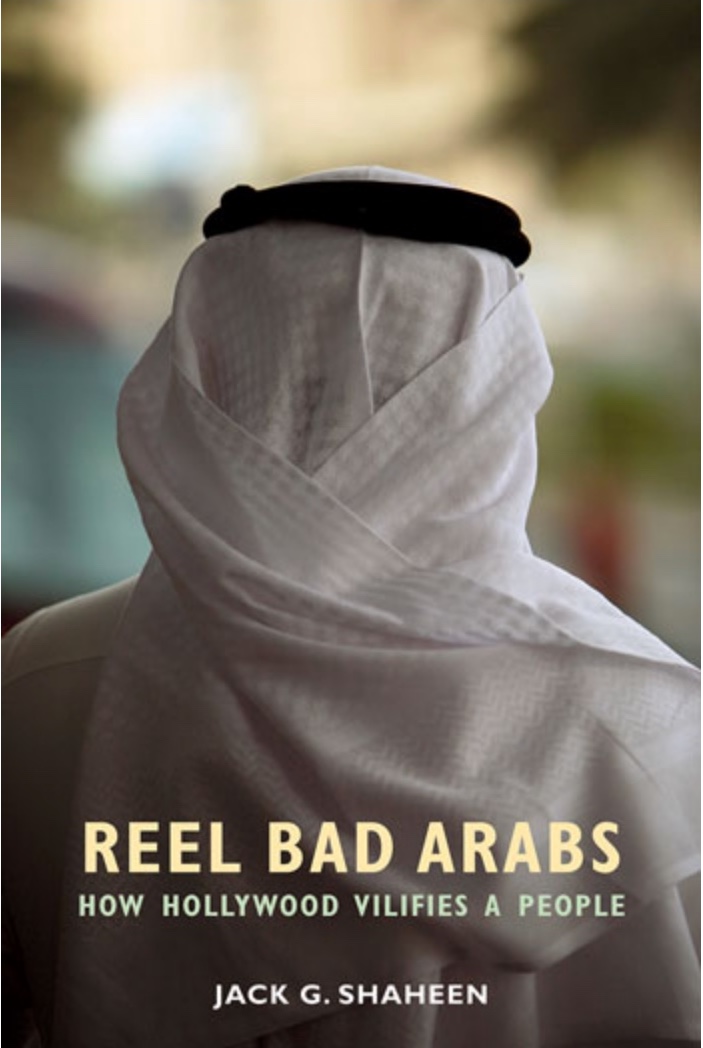 Over the years and decades, Jack Shaheen kept very busy with anti-defamation work, including while a visiting professor at the Kevorkian Center. He wrote a number of books, delivered more than 1,000 lectures around the US and abroad, and fought to have Hollywood studios see how malign their depictions of people of Arab and Muslim identity could be.
Over the years and decades, Jack Shaheen kept very busy with anti-defamation work, including while a visiting professor at the Kevorkian Center. He wrote a number of books, delivered more than 1,000 lectures around the US and abroad, and fought to have Hollywood studios see how malign their depictions of people of Arab and Muslim identity could be.
He was not one to shirk controversy. In 1992 and 1993, for example, he objected to the lyrics in a song in the Disney film Aladdin. He and others protested words in “Arabian Nights”: “Oh, I come from a land / From a faraway place / Where the camels roam. / Where they cut off your ear / If they don’t like you face. / It’s barbaric, but hey, it’s home.”
Such slander was, Shaheen argued, a “painful reminder to 3 million Americans of Arab heritage, as well as 300 million Arabs and others, that the abhorrent Arab stereotype is as ubiquitous as Aladdin’s lamp.”
Disney cut the offensive lines.
Shaheen persisted in such interventions to the end of his life. Says Scharnweber: “He was really tireless and fearless, in that way. He took on these big forces and managed to change them.”
Shaheen’s books, in addition to The TV Arab (Bowling Green State University Popular Press, 1984), included Arab and Muslim Stereotyping in American Popular Culture (Georgetown University Center for Muslim-Christian Understanding, 1997) and Guilty: Hollywood’s Verdict on Arabs After 9/11 (Olive Branch Press, 2012). His Reel Bad Arabs: How Hollywood Vilifies a People (Olive Branch Press, 2001, revised 2012) was adapted to a 2006 documentary film.
Lest his insights end up only in academic circulation, he brought them to larger audiences by various means, such as becoming a consultant on Middle East affairs to CBS News. In 2011, when Turner Classic Movies held a month-long season of films that Shaheen had identified as representative, he appeared as a guest curator, explaining why some were problematic, others less so.
The series included well-known Hollywood features and several animated shorts — ones where Bugs Bunny, Porky Pig, Popeye, and other favorite cartoon characters found themselves among outlandish Arab protagonists.
The films Shaheen commented on were in many regards comparable in their distortions to Hollywood abuses of other racial and ethnic groups — African Americans, Native Americans, and Asian Americans, for example. In the 1921 silent The Sheik, Rudolph Valentino plays an exotic, hot-blooded Arab who declares: “When an Arab sees a woman he likes, he takes her!” The Sheik, Shaheen objected, was one of many undifferentiated film Arabs who together form what Shaheen denounced as “one collective stereotypical lecherous cur.”
Shaheen also noted that in another silent, The Thief of Bagdad (1924), Douglas Fairbanks plays a romanticized, prancing Arabian Nights hero, while among many “Arabs as Villains” has been one in Adventure in Iraq (1943) with Paul Cavanagh as a suave yet lethal WWII-era sheik.
Sirocco (1951) was the first Hollywood film to cast Arabs as terrorists, specifically a group of nuclear-crazed, pro-Nazi Egyptians, Shaheen noted.
Among “Arabs as Subjects of Ridicule,” he said, has been the sultan given to boiling people in oil in Ali Baba Goes to Town (1937), an Eddie Cantor vehicle about a man who dreams of Arabian Nights adventures.


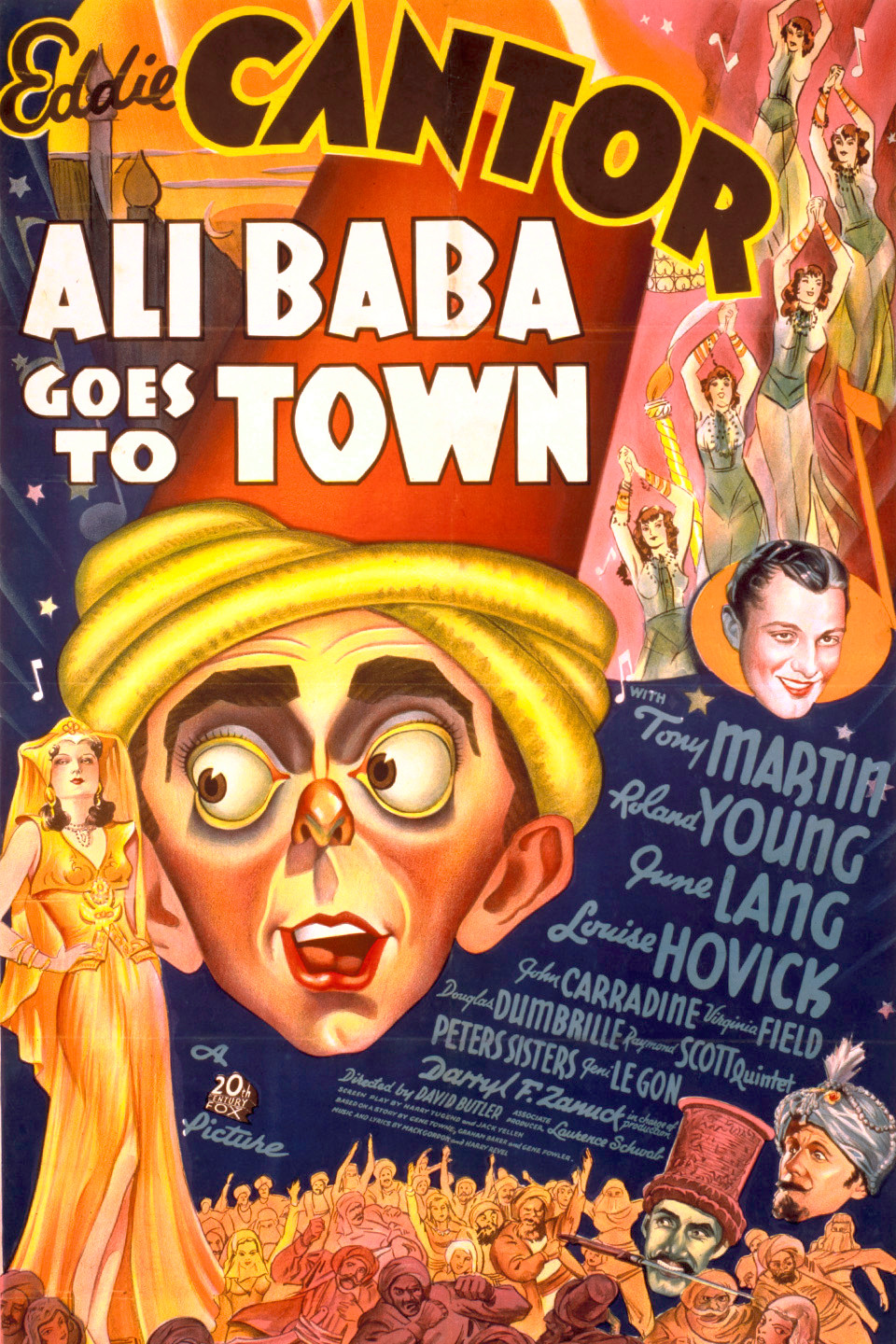
Another Arabs-played-for-laughs venture is The Sad Sack (1957) in which Jerry Lewis is a bumbling soldier kidnapped in Morocco by a band of Arabs including one played improbably by Peter Lorre.
A special case, for Shaheen, due to its importance in film history, was Lawrence of Arabia (1962). In David Lean’s sweeping account of the adventures of T.E. Lawrence (Peter O’Toole) during the Great Arab Revolt, Omar Shariff plays an Arab chieftain, Sherif Ali Ben El Kharish. “In spite of favorable Arab portraits,” Shaheen wrote in Reel Bad Arabs, “shabby stereotypes and historical distortions plague the film” — distortions about, for example, Bedouin customs and Arabs’ capabilities for running civil societies. For these and many other faults, Shaheen, far from agreeing with the American Film Institute that Lawrence of Arabia is the #5 film of all time, accords it a “failing grade.”


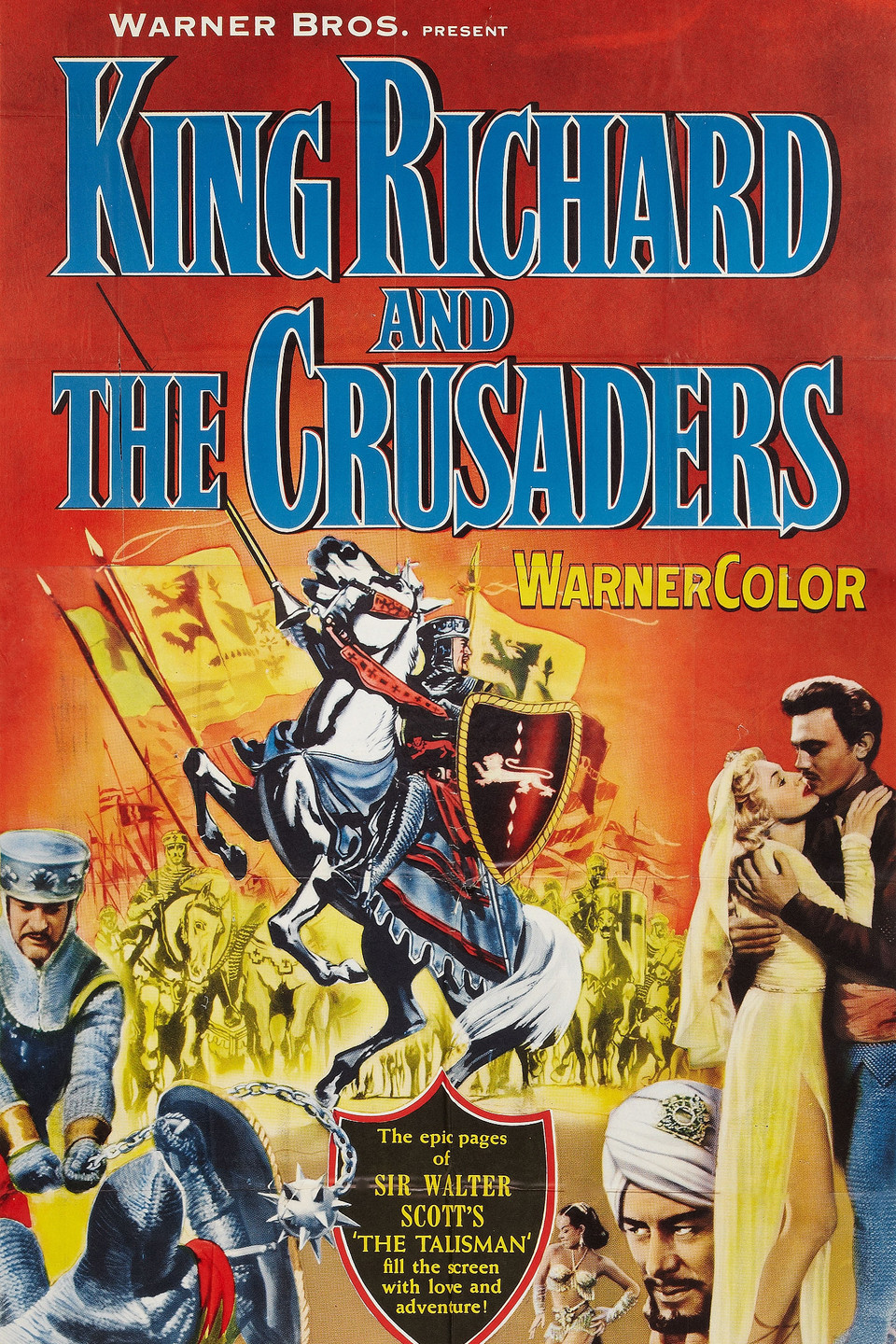
He cites film critic Gary Crowdus: “The film caters to the same old self-flattering Western prejudices about Third World peoples, those benighted colonial subjects who are incapable of ruling themselves.”
Shaheen found some more even-handed portrayals. He thought Lion of the Desert (1981), with Anthony Quinn as WWI Arab Muslim rebel Omar Mukhtar and sympathetic, righteous Arabs who bring down invading fascists, to be a film that “explored the various facets of the human heart.”
Similarly, Five Graves to Cairo (1943) depicts a courageous Egyptian innkeeper Farid (Akim Tamiroff). Also balanced, Shaheen suggested, was the humane Muslim leader played by Rex Harrison in King Richard and the Crusaders (1954) and the depiction of the first Gulf War in Three Kings (1999). There, George Clooney, Mark Wahlberg, and Ice Cube portray American soldiers in Iraq at the war’s close, interacting with Arab characters who were “regular folks, with affections and aspirations,” Shaheen said.
Jack Shaheen’s Legacy
Under educational copyright exceptions, NYU is able to provide access to the materials in the collection at NYU libraries and for classes at the institution. It is keeping Jack Shaheen’s legacy alive with a variety of other activities, too.
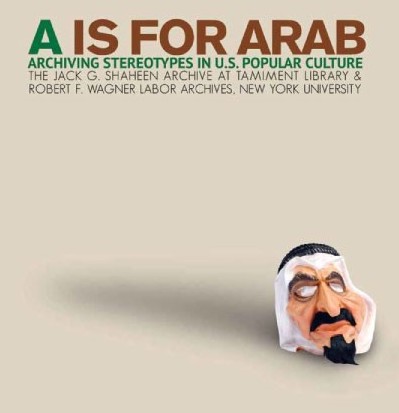 It has, for example, mounted A is for Arab, a traveling exhibition featuring items from the Shaheen Archive. It travels to various kinds of institutions, such as community libraries, high schools, community centers, small museums, and universities, typically staying for a month at each host venue, supporting various awareness activities.
It has, for example, mounted A is for Arab, a traveling exhibition featuring items from the Shaheen Archive. It travels to various kinds of institutions, such as community libraries, high schools, community centers, small museums, and universities, typically staying for a month at each host venue, supporting various awareness activities.
To accompany the exhibition, the Archive published A is for Arab: Archiving Stereotypes in U.S. Popular Culture. It features photographs of materials from the Shaheen Archive, and documents U.S. popular culture representations of Arabs and Muslims from the early-20th century to the present through a set of scholarly essays including one by Shaheen. The essays explain the nature and relevance of the collection.
The Archive also makes available a film program for schools, Reel Arabs Vs. Real Arabs: Historicizing/Critiquing/Remaking the Arab Image in Popular Culture.
Thanks to the work so far of the Tamiment Library at NYU, along with the Kevorkian Center and the Asian/Pacific/American Institute, the Shaheen Archive has been accessible for research and study, with some material held at Tamiment (print material and photographs), the rest at the Avery Fisher Center for Music and Media, or their off-site storage facilities. Many departments and disciplines throughout NYU have made use of the material.
The collection is testimony to Shaheen’s determination, but not surprisingly, says Scharnweber, “I know it was exceedingly painful for Jack to watch these things and to collect them; but he felt it was really important, and we agree — it’s important to know where you’ve been. The aim of Jack’s collecting and our interest in having the collection is out of a desire to move forward from that place.”
 Far from expressing antipathy towards Hollywood and American film, “I think he loved Hollywood movies, and wanted to see the culture, the people that he knows and he loves and that he is a part of reflected in an honest manner on the silver screen,” she says. He advocated for films, including ones by Arab and Muslim filmmakers and actors, that would provide “not a simple positive picture, necessarily, of Arabs and Muslims, but a real one, with complex and multifaceted characters.”
Far from expressing antipathy towards Hollywood and American film, “I think he loved Hollywood movies, and wanted to see the culture, the people that he knows and he loves and that he is a part of reflected in an honest manner on the silver screen,” she says. He advocated for films, including ones by Arab and Muslim filmmakers and actors, that would provide “not a simple positive picture, necessarily, of Arabs and Muslims, but a real one, with complex and multifaceted characters.”
The collection he built was a highly personal one, she says: “Jack collected in a unique and dedicated way, and we feel that the archives is in service to the work that he did. It’s not like there is someone, nor would we want there to be, who will do exactly what Jack did and add it to the archive. A personal archive is just that. For him it was just research and it turned into an archive and it covers a period in history where media was harder to get, on demand.”
The Jack G. Shaheen Lecture
This week [3 May 2018], former presidential candidate, longtime consumer advocate, and friend of Jack Shaheen, Ralph Nader, will deliver the inaugural Jack G. Shaheen Lecture at New York University, to pay homage to Shaheen for his staunch advocacy of more faithful media representations of Arab Americans, and Arabs, in general. Nader has titled his lecture “Ethnicity: Values, Virtues, and Vexations — with Special Attention to Arab Americans.”
Shaheen’s work project remains far from complete. He wrote in Reel Bad Arabs: “From 1896 until today, filmmakers have collectively indicted all Arabs as Public Enemy #1 – brutal, heartless, uncivilized religious fanatics and money–mad cultural ‘others’ bent on terrorizing civilized Westerners, especially Christians and Jews.”
Brutish murderers, sleazy rapists, religious fanatics, oil-rich dimwits, abusers of women… The demeaning depictions are legion, he wrote: “Hollywood’s caricature of the Arab has prowled the silver screen. He is there to this day — repulsive and unrepresentative as ever.”
Postscript: Just how nasty are some elements of the Indiana Jones series? Read on. And on. Eventually it was noticed that some of the “cultural insensitivity” is inflicted on Indians, of the subcontinent variety, but still, little has been said of how Arab-baiting the series has been — how blithely, for example, it equates Nazis and Arabs as meriting being blown up or blown away.
Eventually, it dawns on some audience members.
Printed from Moving Image Archive News: https://www.movingimagearchivenews.org
URL to article: https://www.movingimagearchivenews.org/jack-shaheens-preservation-of-a-troubling-film-legacy/
Click here to print